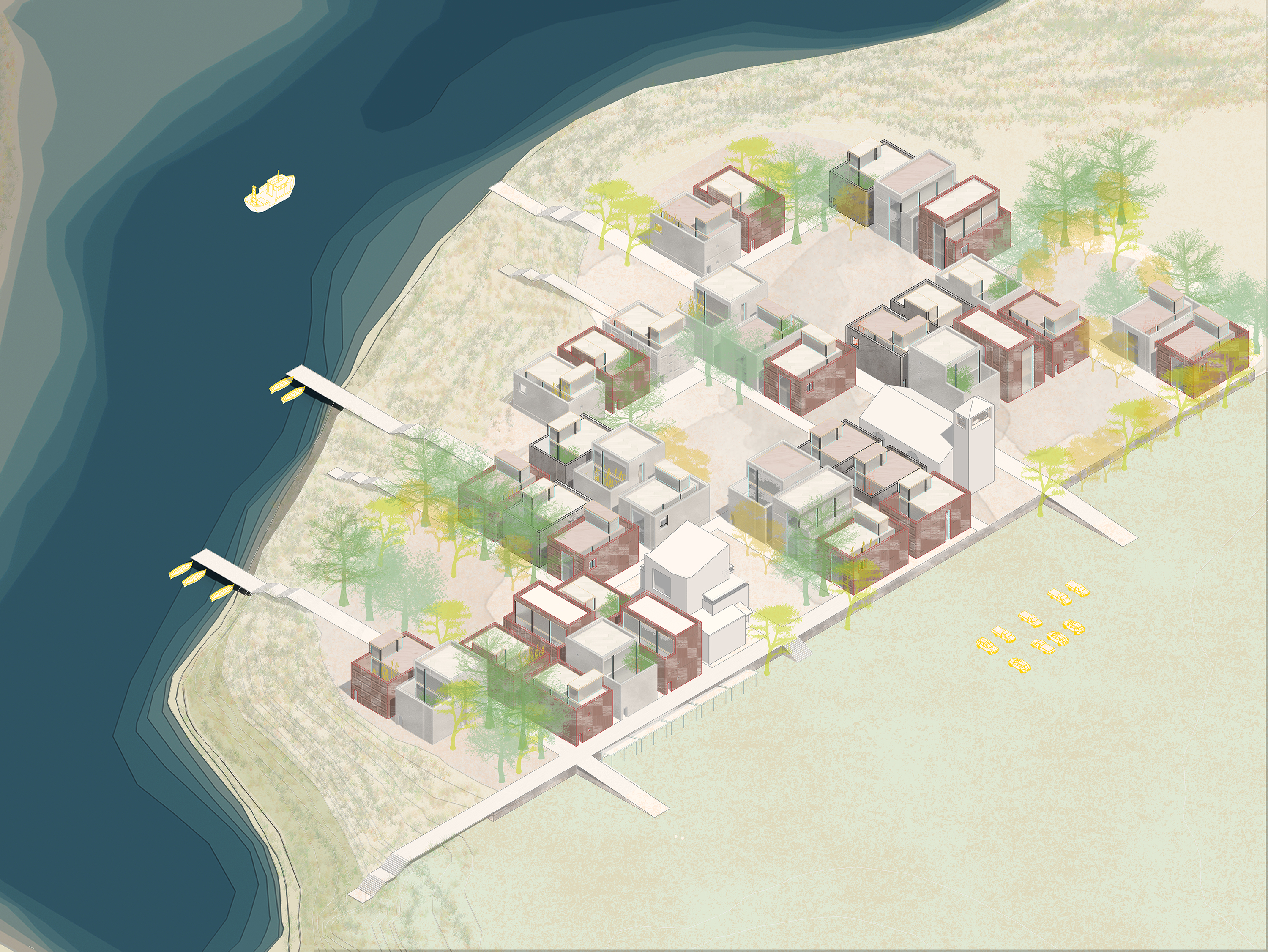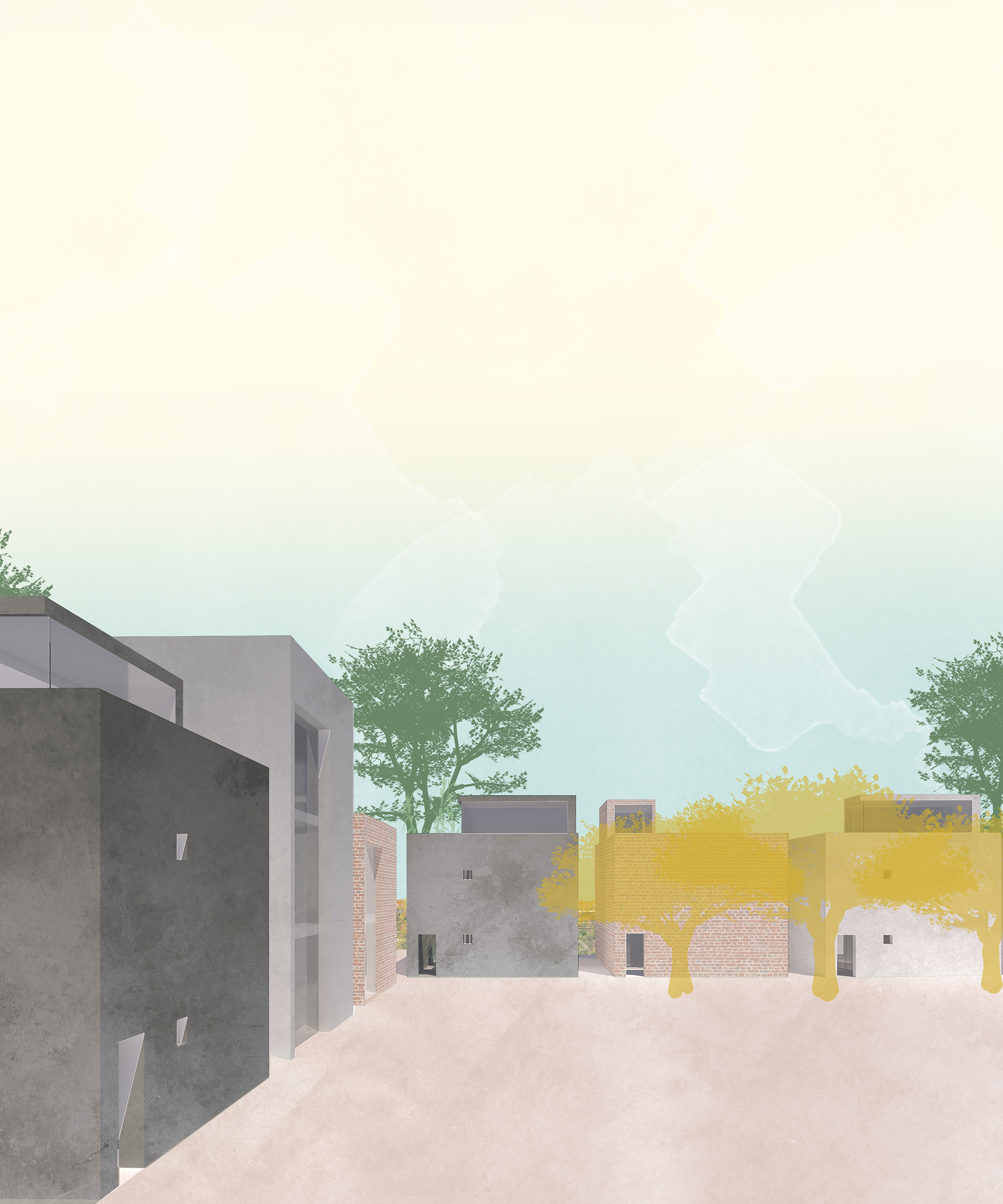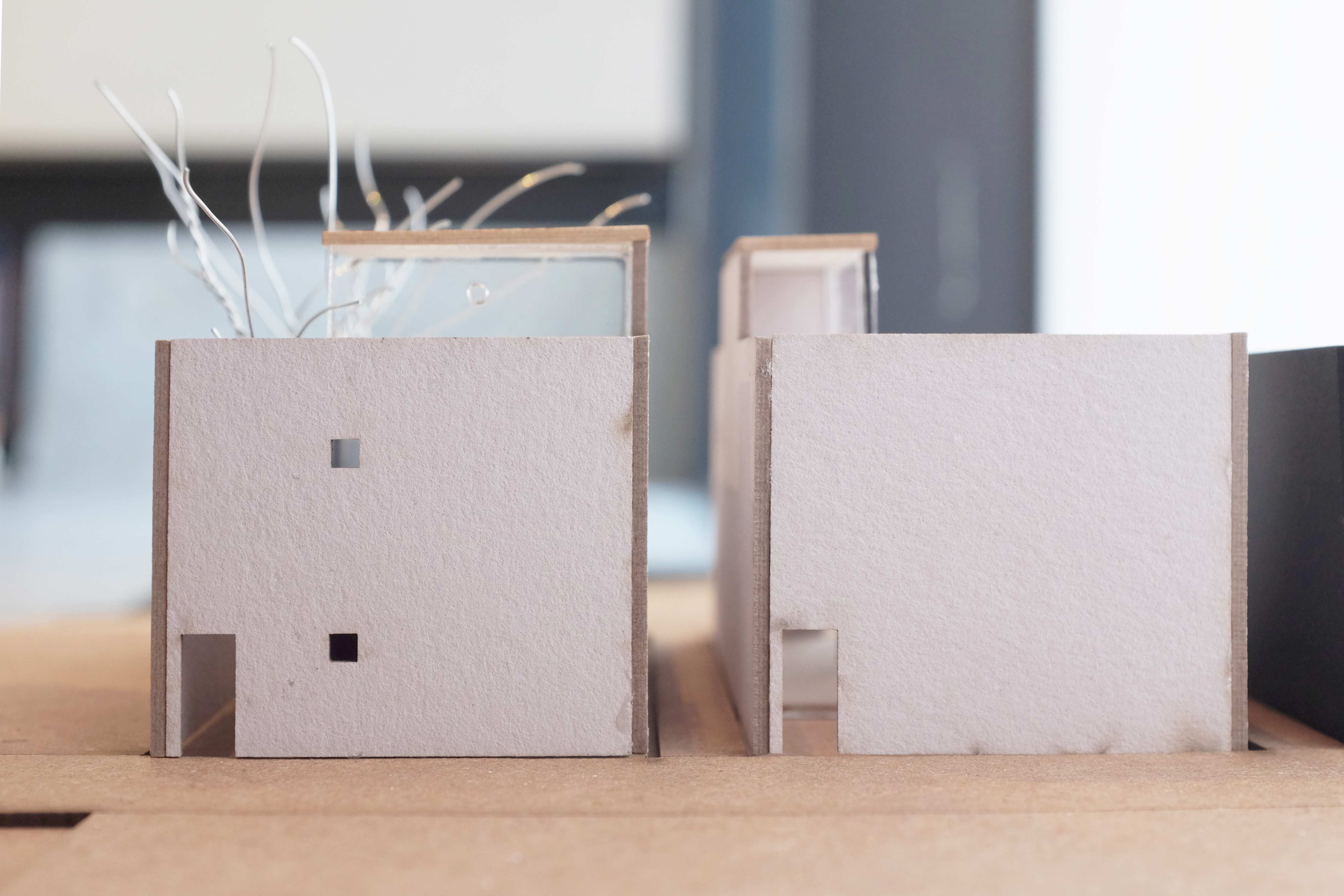Elemental Houses
Collective Living of Climate Migration
Instructor: WG Clark
Individual Work
Year: 2019 Fall
Location: Oyster, VA
Oyster is located at Eastern Shore Virginia. It is a community of about 30 households. The place is 3-ft above sea level, and considering the constant flooding events and future sea level rise, the community is look for a method of relocation.
There are two scales of design strategies. At the community scale, the earth is excavated following the current topography to form a channel. The excavated earth is the used to build a mound for the community to dwell. The channel and the mound could lower the risk of future flooding and inundation. The town consists of three components: square, street, and alley. The squares are public gathering spaces surrounded by individual dwellings. The streets connect dwellings with their surrounding landscape. The alleys are in between two houses and therefore connect the public sphere of the town with the landscape outside.
![]()
The arrangement of houses ensures the privacy of each house, but at the same time connect the private sphere of the house with the public sphere. Each house has two parts: the dwelling part and the garden. There are three types of the dwelling-garden unit: front garden, side garden, and back garden. The arrangement within the unit is depend on the sun path and thus can create variation within the community.
The design strategy of this project can be viewed as a prototype of dwelling – it can be repeated in various places with respect of the particular condition. For me, the design embody my idea of essential, fundamental aspect of living.
![]()
![]()
Individual Work
Year: 2019 Fall
Location: Oyster, VA
Oyster is located at Eastern Shore Virginia. It is a community of about 30 households. The place is 3-ft above sea level, and considering the constant flooding events and future sea level rise, the community is look for a method of relocation.
There are two scales of design strategies. At the community scale, the earth is excavated following the current topography to form a channel. The excavated earth is the used to build a mound for the community to dwell. The channel and the mound could lower the risk of future flooding and inundation. The town consists of three components: square, street, and alley. The squares are public gathering spaces surrounded by individual dwellings. The streets connect dwellings with their surrounding landscape. The alleys are in between two houses and therefore connect the public sphere of the town with the landscape outside.

The arrangement of houses ensures the privacy of each house, but at the same time connect the private sphere of the house with the public sphere. Each house has two parts: the dwelling part and the garden. There are three types of the dwelling-garden unit: front garden, side garden, and back garden. The arrangement within the unit is depend on the sun path and thus can create variation within the community.
The design strategy of this project can be viewed as a prototype of dwelling – it can be repeated in various places with respect of the particular condition. For me, the design embody my idea of essential, fundamental aspect of living.







Statement of Ideal Dwelling
Powered by fossil fuels and driven by capital, rapid urbanization process and its generic real estate typologies disregard any environmental consequences. The problem is twofold. One the one hand, there is a careless attitude towards the environment – just look at human’s effects on climatic, hydrologic, and any other biological process. On the other hand, there is a normalizing tendency in the built environment – just look at the city of tall office buildings and apartments, or the suburban of sameness.
Nonetheless, we are living in a capitalism society and building an architecture is not going to resolve the entire economic system. What I intend to advocate is a sense of belonging.
People should live together, because it allows us to be mutually depend on one another, and because it allows us to be less destructive to the earth. The dwelling should be a place to respectfully occupy the land, and a space to respectfully ignore each other.
To see the land as a property which can be divided and sold is contributing to the rampant individualism that is widely accepted today. People are isolated inside their properties and protective over things they believe they own. This kind of individualism which popularized by capitalism is deeply at odds with who we are as human. We are social creatures who depend on each other to survive.
A collective living space is not to erase people’s identities. Instead, it is a space to allow for the possibility of variation. It should be a space in which people can feel comfortable being whoever they are, instead of feeling trapped in particular roles. The dwelling can organize people’s activities – regulate, constrain, and hopefully, occasionally it can liberate us. At the same time, a collective living space is a place of mutual reliance. It should provide common spaces for people to cultivate the sense of belonging – both the belonging of a human society and the belonging of the land.
![]()
![]()
![]()
![]()
![]()
![]()
Detail Section and Material Selection
![]()
Community Perspective
Powered by fossil fuels and driven by capital, rapid urbanization process and its generic real estate typologies disregard any environmental consequences. The problem is twofold. One the one hand, there is a careless attitude towards the environment – just look at human’s effects on climatic, hydrologic, and any other biological process. On the other hand, there is a normalizing tendency in the built environment – just look at the city of tall office buildings and apartments, or the suburban of sameness.
Nonetheless, we are living in a capitalism society and building an architecture is not going to resolve the entire economic system. What I intend to advocate is a sense of belonging.
People should live together, because it allows us to be mutually depend on one another, and because it allows us to be less destructive to the earth. The dwelling should be a place to respectfully occupy the land, and a space to respectfully ignore each other.
To see the land as a property which can be divided and sold is contributing to the rampant individualism that is widely accepted today. People are isolated inside their properties and protective over things they believe they own. This kind of individualism which popularized by capitalism is deeply at odds with who we are as human. We are social creatures who depend on each other to survive.
A collective living space is not to erase people’s identities. Instead, it is a space to allow for the possibility of variation. It should be a space in which people can feel comfortable being whoever they are, instead of feeling trapped in particular roles. The dwelling can organize people’s activities – regulate, constrain, and hopefully, occasionally it can liberate us. At the same time, a collective living space is a place of mutual reliance. It should provide common spaces for people to cultivate the sense of belonging – both the belonging of a human society and the belonging of the land.






Detail Section and Material Selection

Community Perspective

Front-Garden Perspective


Side-Garden Perspective



